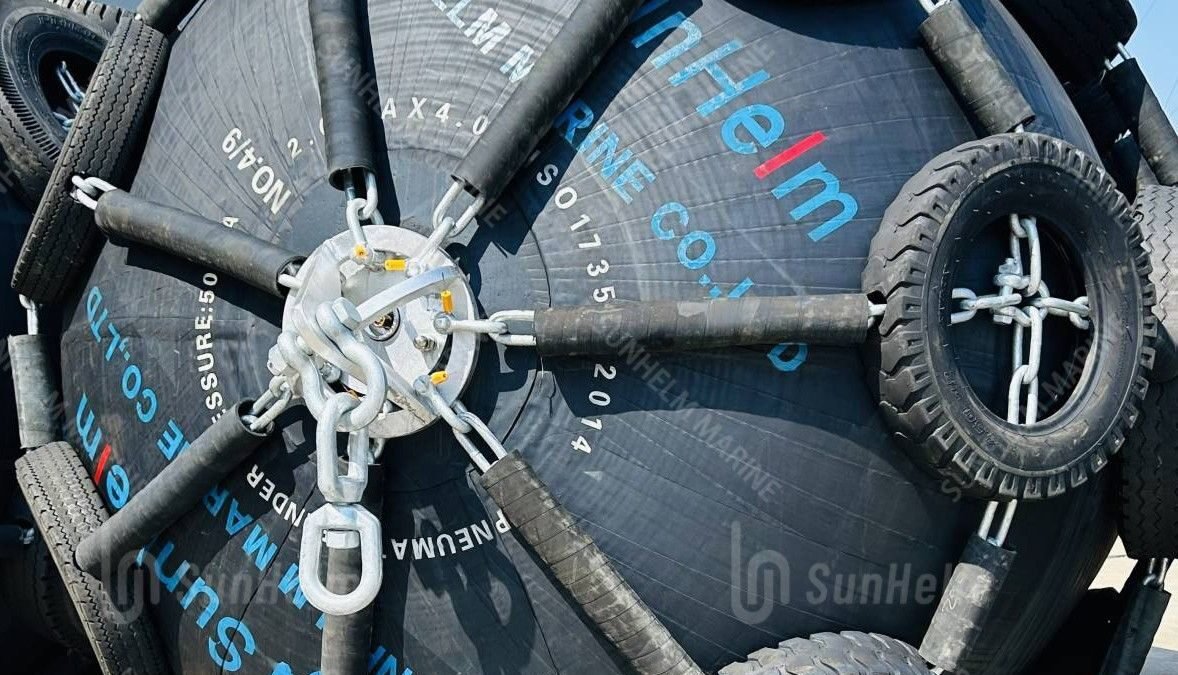Navigating icy waters presents unique challenges for maritime operations. Pneumatic fenders play a crucial role in safeguarding vessels and port infrastructure. While traditional pneumatic fenders are generally robust, extreme cold and the presence of ice demand specialized solutions to ensure their optimal performance and longevity.

Challenges of Extreme Cold and Ice
When temperatures drop, standard rubber compounds can become stiff and brittle. This significantly compromises a fender’s ability to absorb energy, increasing the risk of cracking or breaking on impact. Rubber also contracts in the cold, potentially creating gaps between the fender and the vessel or dock. These gaps can reduce the effective contact area and compromise energy absorption.
Moisture infiltration is another major concern. If water seeps into the fender and freezes, it can cause internal damage, compromising the fender’s integrity. Furthermore, ice buildup on the fender’s surface reduces flexibility and effectiveness, potentially hindering its ability to absorb impacts. Constant rubbing against ice also accelerates wear and tear on the fender’s outer layer.
Pneumatic Fender Solutions for Extreme Cold
To address these challenges, manufacturers have developed specialized pneumatic fender solutions. These often incorporate advanced materials and design features.
Cold-Resistant Materials
EPDM (Ethylene Propylene Diene Monomer) is a synthetic rubber known for its excellent low-temperature flexibility and durability. This makes it a preferred material for fenders in cold climates. Manufacturers also use specific rubber formulations designed to maintain flexibility and energy absorption capabilities even in extreme cold. For instance, Sunhelm’s pneumatic fenders are engineered to operate normally even at -50 degrees Celsius, showcasing their superior performance in harsh, icy conditions. These formulations reduce the risk of brittleness and cracking.
Enhanced Design Features
Thicker walls and robust structures help counteract potential brittleness and maintain energy absorption capacity in cold conditions. Hydro-pneumatic fenders are another specialized option, often used for submarine docking. These fenders contain a mixture of air and water. Their design is less affected by extreme climatic conditions, ensuring continuous protection for submerged hulls. They also feature a protective sleeve to shield the body from wear and the marine environment.
Protective Coatings and Systems
Applying protective coatings prevents moisture infiltration, which can lead to freezing and internal damage. Some coatings even actively repel ice formation, helping to maintain the fender’s flexibility and performance. Many pneumatic fenders, like the Yokohama type, feature a Chain-Tire-Net (CTN) system. This lattice of tires and chains provides additional protection to the fender’s outer skin. It guards against abrasion from ice and other elements. Manufacturers often use galvanized chains and rubber sleeves for corrosion resistance and to prevent abrasion of the fender’s rubber surface.
Inflation and Pressure Management
It’s crucial to implement systems that track temperature and fender condition, as internal air pressure can fluctuate with temperature changes. Always inflate the fender to the manufacturer’s recommended pressure and check it regularly. This ensures optimal performance in all conditions, including extreme cold.
Specialized Fender Types
Yokohama fenders are widely recognized for their high energy absorption and low reaction force. Many manufacturers, like NANHAI, specifically state that their Yokohama fenders maintain flexibility and energy absorption capabilities in low temperatures. This makes them suitable for cold climates and icy environments. They are designed to withstand harsh environmental conditions, including extreme temperatures.
Maintaining Performance in Icy Waters
Beyond specialized design, proper maintenance and operational practices are key. Regular inspections for signs of wear, air pressure levels, and overall integrity are essential. When not in use, store fenders in a cool, dry place, away from direct sunlight, chemicals, and extreme temperatures. Slight inflation can help maintain their shape.
It’s also important to select fenders appropriate for the vessel’s size and docking conditions. This ensures adequate protection. Finally, fenders must be securely attached to prevent gaps caused by thermal contraction.
By combining advanced material science with robust design and diligent maintenance, pneumatic fender solutions can effectively navigate the challenges of extreme cold and icy waters, ensuring safe and efficient maritime operations.


